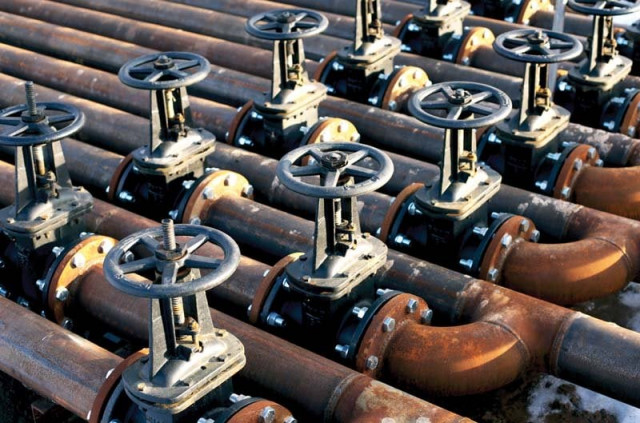Pakistan starts banking on natural gas, LNG imports
Significant progress made on LNG import, TAPI pipeline projects in 2015

Significant progress made on LNG import, TAPI pipeline projects in 2015.
Year 2015 saw major developments in Pakistan’s energy sector when investors found more opportunities and the country emerged as a potential buyer of gas on the world energy map.
Oil consumers got a big relief as global crude prices plunged more than 50%, but there was no end to the sufferings of gas consumers who continued to face load-shedding in winter.
CNG industry wins nod for direct LNG import
In an effort to meet growing demand, the government took some steps to secure energy supplies for the future including the Turkmenistan, Afghanistan, Pakistan and India (Tapi) pipeline that would bring gas and ensure peace in the region by connecting South Asia with Central Asia and Europe.
For long-term energy security, the country started importing liquefied natural gas (LNG) for the first time in 2015 and built the first LNG terminal. The government had also been making strenuous efforts to strike a 15-year state-to-state LNG deal with Qatar, but the matter dragged on in the absence of an agreement with power producers over the payment mechanism. In the meantime, Pakistan State Oil floated a tender for short-term supply contracts and declared energy giants Gunvor and Shell as successful bidders. They would supply 120 LNG cargoes over the next five years.
The government believes that LNG consumption in power plants by replacing the expensive furnace oil will help to save $2 billion a year and bring down power tariff for the consumers.
Apart from power generation, the LNG will also be consumed by compressed natural gas (CNG) outlets and fertiliser plants to run their operations smoothly, which was not possible with domestic natural gas supplies. In 2015, the two sectors also got some LNG to operate their businesses.
Govt mulls forming ‘Pakistan LNG Limited’
During the year, Pakistan awarded contracts to China and Russia for constructing LNG pipelines including the Gwadar pipeline and the North-South pipeline.
Gwadar pipeline
Pakistan and China, during President Xi Jinping’s visit, signed a government-to-government deal to award the Gwadar LNG pipeline and terminal contract to a Chinese firm without bidding.
Beijing would provide 85% of financing at a concessionary rate for the pipeline, which was expected to cost less than $2 billion.
This would serve as an alternative to the long stalled Iran-Pakistan (IP) pipeline project due to international sanctions on Tehran. However, hopes arose after global powers and Iran signed a nuclear deal, which would clear the way for the IP pipeline and allow extension of the Gwadar pipeline to the Iranian border.
Under the IP project, Pakistan would be able to import 1 billion cubic feet of natural gas per day (bcfd).
Tapi project
Pakistan, Turkmenistan, Afghanistan and India performed on December 13 the groundbreaking of Tapi pipeline project, which was conceived 25 years ago. Of the total cost of $10 billion, Turkmenistan agreed to make 85% of investment whereas the remaining equity would be equally shared by Pakistan, Afghanistan and India.
LNG pipeline, terminal: Govt to decide on Chinese firm’s bid in a month
Turkmenistan would also invest $15 billion in developing the field from where gas would be exported.
“The cost of two pipelines – Gwadar LNG pipeline including the terminal and Tapi – is estimated at $12 billion,” Inter State Gas Systems Managing Director Mobin Saulat said, adding Pakistan would have to provide only $500 million to execute these projects.
Pakistan would import 1.3 bcfd of gas through the Tapi pipeline whereas 600 million cubic feet of LNG per day (mmcfd) would be imported and handled at the Gwadar terminal.
North-South pipeline
For laying an LNG pipeline from Lahore to Karachi, called North-South pipeline, Pakistani and Russian governments signed an agreement last year. Russia would spend 85% of the $2 billion cost of the project.
At present, gas utilities have the capacity to transport only 400 mmcfd of LNG through their pipeline networks.
LNG-based: Dar stresses swift progress on power projects
These projects will prove to be a milestone as Pakistan has been heavily banking on oil imports since long. These would help to meet the targets set at the recent climate summit in Paris. As part of the declaration signed at the summit, every country would take steps for ensuring a friendly environment.
Geopolitical significance
Year 2015 opened opportunities for lucrative energy supplies to Pakistan by major world powers. Russia came forward to lay the LNG pipeline whereas China agreed to build the Gwadar pipeline. On the other hand, the United States was also indirectly involved by giving its full backing to the Tapi project.
This showed a shift in Pakistan’s foreign policy, which was heavily tilted towards the US in the past, as it had also started developing ties with other powers.
The writer is a staff correspondent
Published in The Express Tribune, January 4th, 2016.
Like Business on Facebook, follow @TribuneBiz on Twitter to stay informed and join in the conversation.



















COMMENTS
Comments are moderated and generally will be posted if they are on-topic and not abusive.
For more information, please see our Comments FAQ